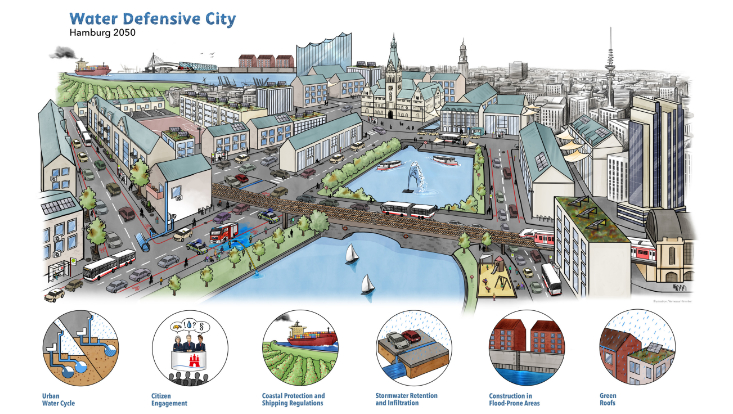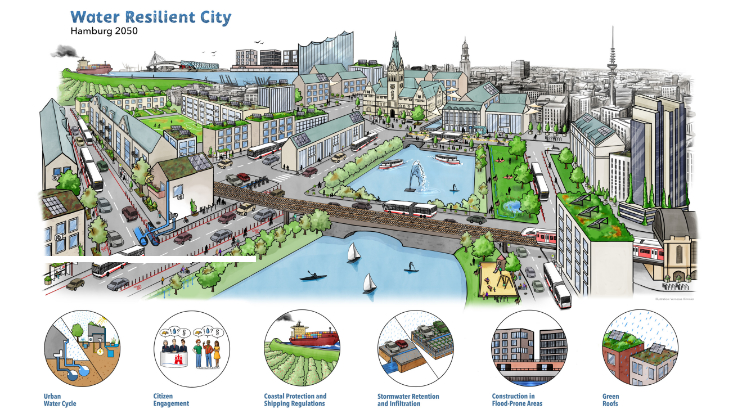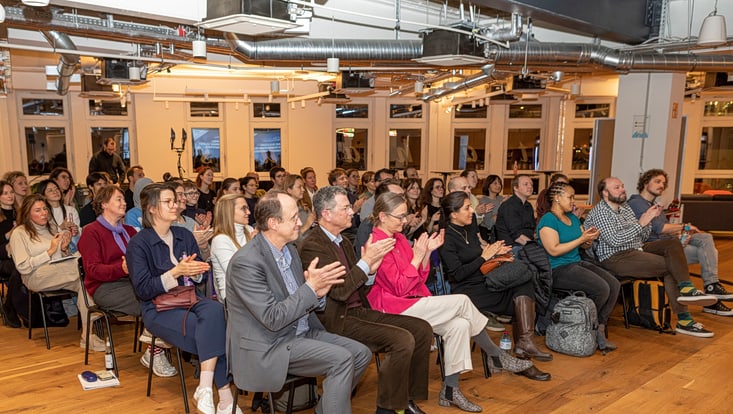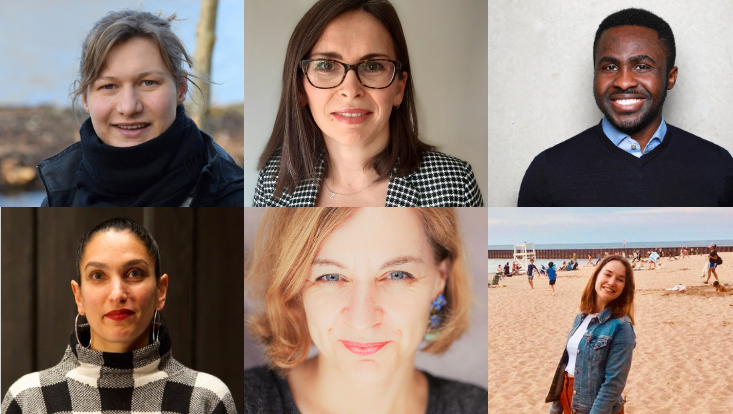Research communication fundingMaking interrelations tangible – Dr. Franziska S. Hanf on her project "Hamburg 2050: water from 4 sides"
30 January 2025
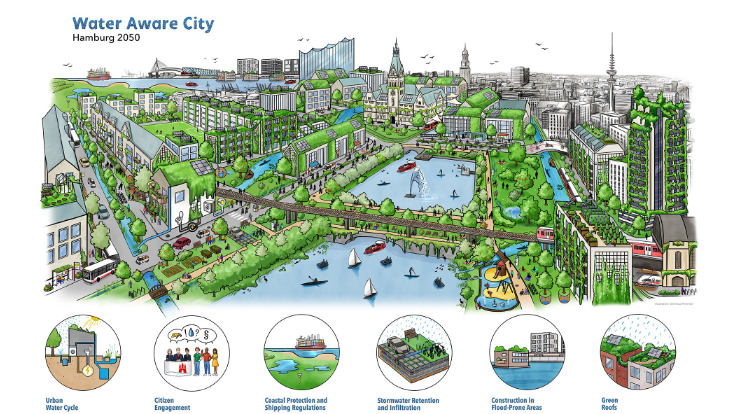
Photo: © Vernessa Himmler/Hanf et al. 2024
In her project “Hamburg 2050: water from 4 sides”, Dr. Franziska S. Hanf, together with her colleagues from the CLICCS cluster of excellence and an illustrator, used art to develop three adaptation scenarios for the city of Hamburg. These ‘narrative images’ illustrate three different ways of adapting to water risks in a changing climate. The narratives of the scenarios were previously developed in an interdisciplinary team as part of the CLICCS C1 project. The visualization of the scenario narratives was funded by the Hamburg Research Academy support fund for research communication.
How did you come up with the idea for the project?
There are three different categories of adaptation to climate change: immediate disaster management ("coping"), step-wise and context-specific adjustments to increase efficiency ("incremental adaptation") and a fundamental change of structures and processes, i.e. transformation ("transformative adaptation"). However, these three categories are not always easy to distinguish, and it is difficult to move from the conceptual level to an empirical and practical understanding. This is also our experience in our interdisciplinary CLICCS research team. To facilitate access to the topic, art should be a solution.
‘Narrative images’ can be seen as mental tools that help a community to perceive complex socio-ecological problems in an easily understandable way and at the same time stimulate discussion. Within the interdisciplinary team, the step-by-step visualization process was intended to help explore socio-ecological interrelations and integrate the knowledge of the different disciplines involved. The step of visualizing the narratives stimulated discussions to bring the abstract understanding of the three categories of climate change adaptation to an empirical and practical level.
Overall, however, we wanted to reach two target groups with the visualization: Science and society. Our aim was both to promote interdisciplinary learning among scientists through the joint development of scenarios using the arts, and to apply the results to stimulate social learning among various local stakeholders such as citizens, authorities and companies.
What challenges did you face when translating your research into graphic representations?
The biggest challenge is the complexity of the topic. Adapting to the water risks in the city is so multi-dimensional and wide-ranging. It cuts across all sectors: health, transportation, energy, economy/industry, nature/biodiversity, recreation, education, etc. Capturing all these dependencies in the graphical representations was a major challenge. During the visualization, we repeatedly became aware of new connections that we had initially overlooked. This shows the enormous importance of this process step in the overall study.
How did the support fund help you?
Thanks to the support fund, we were able to take our time during the visualization process and go through several loops in order to repeatedly question the visualizations and reflect on them together. Interdisciplinary work requires time, which is not always available in academia. Taking the time and focusing on this not only benefits the current project in the end. It also influences the expertise of everyone involved and opens up new scientific horizons.
How do you intend to use the resulting visualizations in the future?
Six comprehensive graphics were created as part of the funding: There are two graphics per scenario, one in English and one in German. The English graphics were used for a scientific publication that presents the development process of the scenarios within the interdisciplinary team and the results. The German graphics are to be presented to a broad audience in the city of Hamburg at a stakeholder workshop. In this way, we want to motivate various social actors to deal with the complexity of (sustainable) urban adaptation to climate change and the associated challenges in water management. The ‘narrative images’ are intended as a starting point for discussions about socially constructed futures. They are intended to promote social learning about the complexity of socio-ecological interdependencies in cities and motivate both decision-makers and citizens to engage with the topic together. Following a successful kick-off stakeholder workshop entitled "Adapting to climate change for a sustainable Hamburg - what measures will transform the city?", we are now planning another stakeholder workshop on the topic of "scenarios" for this year. Research communication is and will therefore remain an important part of my work.
Further information on the project
-
The publication with the resulting visualizations in English: Hanf FS, Meier L, Hawxwell T, Oßenbrügge J, Knieling J and Sillmann J (2024) “Narrative images” as a learning approach: (transformative) adaptation scenarios for dealing with urban water risks in Hamburg, Germany. Front. Sustain. Cities 6:1430257. doi: 10.3389/frsc.2024.1430257
-
Report on the first stakeholder workshop in the CLICCS News
Research communication funding
You have a good idea, but do not have the funds you need to implement it? The Hamburg Research Academy, in conjunction with the Claussen-Simon Foundation, provides funding to early career researchers for projects in the area of research communication. You can apply for funding for you own projects from the Hamburg Research Academy fund.

